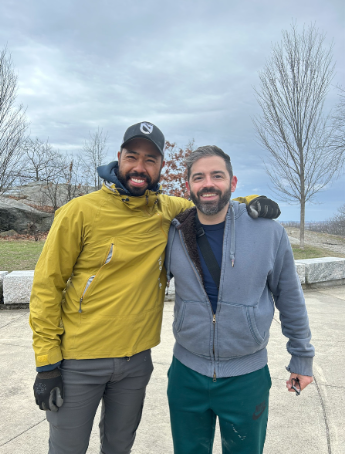On April 7th, City Hall held a Downtown Public Art Community Workshop to “establish a public arts inventory for the downtown neighborhood and then cite new locations for new public art.” Rebekah McPheeters, City Hall Sustainability and Grants Manager, explained, “So whether it be sculptures or murals, or anything really, we want to get the public’s input on where those should go and what they would like to see.”
As everyone came and settled in, they began going over the agenda and the existing art map. They hoped to get the public’s opinions about what art they want to see and where in Malden they want to see it. “We’re hoping for this to bring a sense of connectedness to our community and a way to honour the different people and cultures that we have in our city, and make sure that the art is reflecting that and making it feel like a place that people would want to be,” McPheeters said.
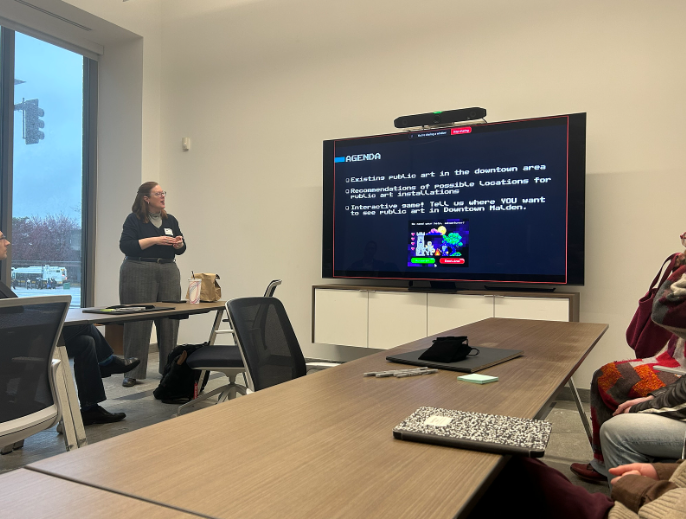
City Counselor Kevin Duffy introduced their gaming district in Malden. He explained how the concept began in 2015 when Boda Borg opened, since there are only eight in the entire world. 250,000 tourists visit Malden annually to go to Boda Borg.
“Once they got rolling and were all set up, we noticed how many people were coming for Boda Borg. We saw businesses that were already here starting to tailor what they offer to capture some of those customers that were coming to Boda Borg,” Duffy explained. “So, we’re bringing all these people in from Boda Borg, and there will be other businesses that will want to be in that customer stream, so we started reaching out to recruit businesses to come and open up. We try to offer a complete array of fun, interactive things to do.”
Duffy then began to explain this idea of experiential retail, which means that you have to go out, actually experience what you are doing, and it is not something you can just sit at home and do.
“You can’t get it from Amazon, you can’t buy it in a big box, that’s kind of what has been hurting a lot of the downtown, people don’t have to go out to do these things,” Duffy explained. He further added how it is about being there, being present, and being a part of what you’re doing. “By being there, you pay for parking, you go to eat afterward, and you might do some shopping, so it really becomes a spin-off multiplier. This is the economic engine that is driving downtown at the moment.”
Jimmy Rocha a spatial/data analyst, with Innes Associates, went up to walk everyone through the “Malden Gaming District” website. He taught everyone how to use the website and how to see more information on the map as well as the collaboration map. He offered assistance to those online as well and made sure everyone was involved.
“It’s important to make sure everyone has a voice. I know that everyone might not be able to attend the public workshop, so I believe it’s important to publish it on the internet so everyone has a chance to give us their input and tell us where they want to see art,” Rocha explained.
He encouraged everyone to interact with the website, submit pins where they would like to see public art, leave comments, and especially give feedback for improvement in the future because they are “open to suggestions at all times.”
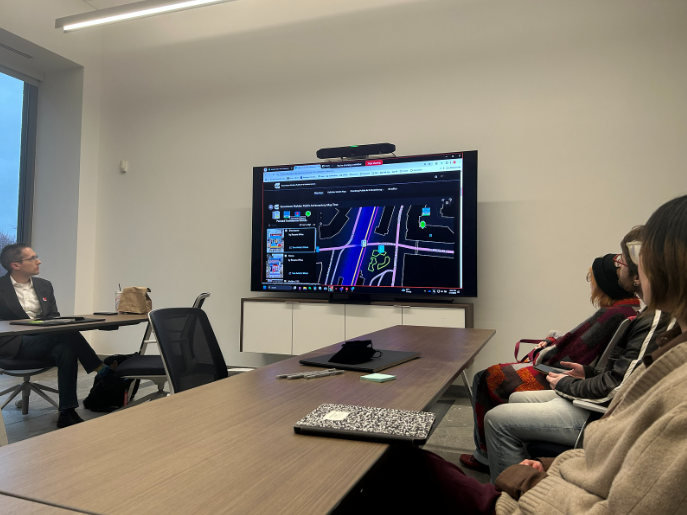
The map displays existing public art as well as locations of possible new art. Nothing was off limits; they wanted to see all kinds of art, including monuments, plaques, anything that could be installed on the wall or even on the ground. They wanted people to think about public art, vibrancy and how it connects to culture and the location it is in.
Everyone then separated into smaller groups for the interactive portion. Each group had a big physical map with all the locations where there could possibly be new art. Everyone was provided sticky notes where they could place areas they thought art would increase the vibrancy of and improve the overall visual appeal. The sticky notes represented the specific kinds of art they wanted to see. They would write it down and place it on the map.
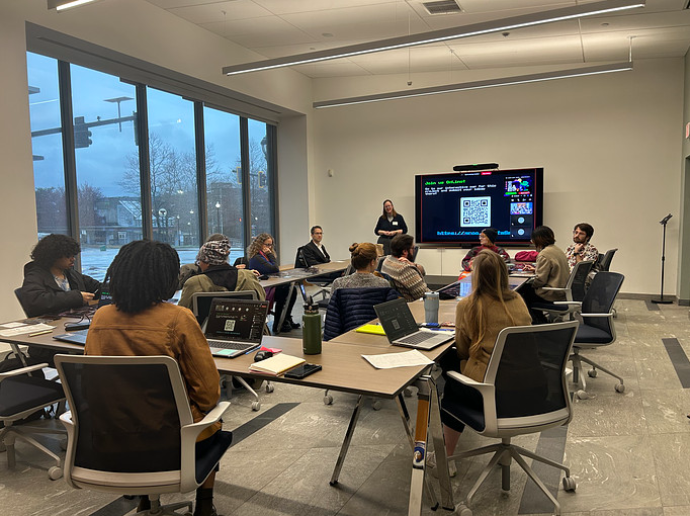
Everyone was asking themselves questions like: “Where do I want to see art? What can be considered art?” People had many creative ideas like using stickies to create art installations, music or sound installations, and poetry or significant sayings engraved on walls. Someone brought up the Scottish Parliament, a wall where they have quotes from Scottish writers engraved into the wall, located in Scotland, to give people inspiration.
If people in different groups want to put different art in the same location, they could consider layering or another way to make it possible. Just because they both have different ideas in the same place does not mean they can only choose one.
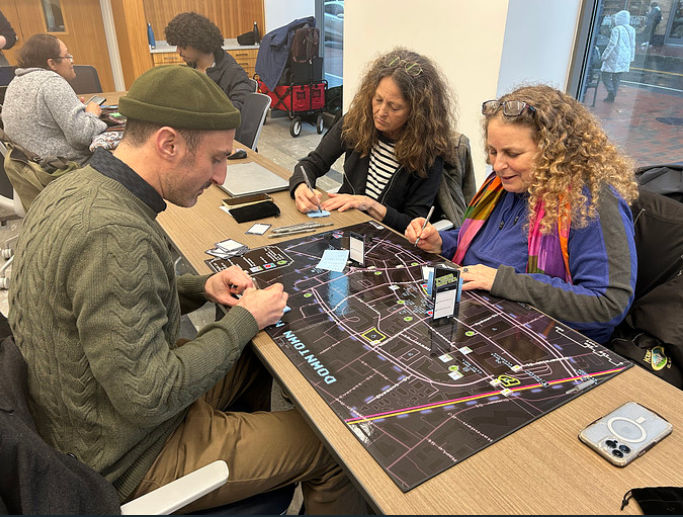
Nearing the end, everyone grouped for a “report back” in which they would tell everyone about something they would like to see in Malden. A lot of people had many creative ideas, one was using creative visualizations in places where you could look up or on the ground. Someone also shared an idea for a scavenger hunt for people to go on and that it should be more on the off path so they do not just experience the art while passing, they might even go out of their way to experience more.
Attendee Osw Schwab had the creative idea of having a portable theater. She explained how the “city hall plaza is a perfect attraction spot for performance art, music, dance, mime, or theater.”
“The idea is that throughout the seasons that are warm enough, you can have different installations, where they’re scheduled to provide some entertainment,” voiced Schwab. It would be cool to have some kind of platform to make it clear that it is a stage, and that in itself could be colorful and artistic.”
Seeing art around the city can lift people’s spirits and can also raise awareness for certain things. Schwab would best describe it as a “dialogue with the everyday.” She said, “Life is challenging, and to have color and things that catch my imagination it can distract me from problems or the dreary rain.”
Seeing art around the city can lift people’s spirits and can also raise awareness for certain things. Schwab would best describe it as a “dialogue with the everyday.” She said, “Life is challenging, and to have color and things that catch my imagination it can distract me from problems or the dreary rain.”
– Ose Schwab
McPheeters believes that people not only feel proud of a place when they see art, but when they “see art that reflects them, so that’s what we’re going for. I hope that this is an opportunity where the public feels like their input is heard and that they get to see art in the coming years that looks like what they asked for.”
When you enter a space with public art, the atmosphere instantly feels lighter, and there’s a real sense of joy, making the environment much more enjoyable. Duffy believes that “if we create a great space that people will want to come back to, businesses will benefit.”
He explained that this is a chance for people to come in and change their environment: “If you want to see more art, come down and take part. There’s a number of times the city will throw out their hands and say ‘Please come and give us your suggestions because we’re going to build off those.’ This is one of those times.”
“People can come in, put out their ideas, and in a short amount of time, see those ideas become reality,” Duffy finished.



